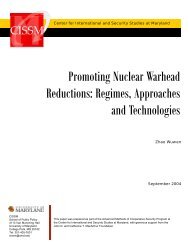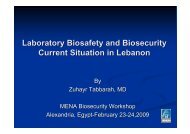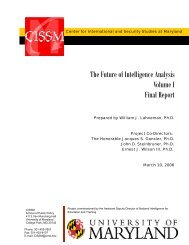A Reassurance-Based Approach to Space Security - Center for ...
A Reassurance-Based Approach to Space Security - Center for ...
A Reassurance-Based Approach to Space Security - Center for ...
- No tags were found...
You also want an ePaper? Increase the reach of your titles
YUMPU automatically turns print PDFs into web optimized ePapers that Google loves.
(NTM) or because noncompliance can easily occur <strong>for</strong> reasons other than deliberatecheating, the more important it is <strong>for</strong> the treaty <strong>to</strong> include cooperative means <strong>for</strong> assessingcompliance and addressing compliance concerns. 24The OST has even less in these regards than the 1957 Antarctic Treaty, the oneearlier multilateral Cold War non-armament agreement. Under the OST, members agree <strong>to</strong>provide in<strong>for</strong>mation about the nature, conduct, locations, and results of their space activities“<strong>to</strong> the greatest extent feasible and practicable” (Article XI); they can “on a basis ofreciprocity” observe other members’ activities on celestial bodies (Article XII); and they areobliged <strong>to</strong> consult be<strong>for</strong>e carrying out activities that might interfere with other members’ useof space and have the right <strong>to</strong> request a consultation if they are concerned about potentiallyharmful interference from somebody else’s space activities (Article IX). In principle, OSTmembers could use these provisions <strong>to</strong> interpret the peaceful use requirement as alreadyoutlawing any type of orbiting strike weapon, but this would require a special diplomatic orlegal initiative, because the treaty has no built-in review process or other routine mechanism<strong>for</strong> aggregating members’ concerns. 25 In practice, even the treaty’s minimalist transparencyand consultation mechanisms have rarely been used. 26As a package, the three new rules proposed by the Canadian working paper wouldaddress the most important concerns raised by the Chinese and Russians, the Europeans,and the United States. It would also cover both dedicated space weapons and dual-usecapabilities employed as weapons. Because physical combat in and from space would crossan important threshold <strong>for</strong> space security and would likely permanently damage the spaceenvironment, the Canadian proposal concentrates on three central prohibitions against:1) placing in orbit around the Earth any weapon or any objects carrying weapons,or stationing weapons in outer space in any other manner;2) testing or using anything as a weapon against any satellite so as <strong>to</strong> damage ordestroy it; and24 Abram Chayes and An<strong>to</strong>nia Handler Chayes, The New Sovereignty: Compliance with International Regula<strong>to</strong>ryAgreements (Cambridge, MA: Harvard University Press, 1995).25 George Bunn and John B. Rhinelander, “Outer <strong>Space</strong> Treaty May Ban Strike Weapons,” Letter <strong>to</strong> the Edi<strong>to</strong>r,Arms Control Today (June 2002). Concerns about compliance with the OST have been raised in political <strong>for</strong>asuch as the U.N. General Assembly and COPUOS.26 The United States moni<strong>to</strong>red the two flight tests that China conducted be<strong>for</strong>e its January 2007 ASATintercept, but expressed no concerns, which may have led Chinese leadership <strong>to</strong> assume that the United Stateswould not object after the intercept occurred, either. The United States did not issue a demarche immediately,but waited <strong>for</strong> more than a week until leaked news of the ASAT test appeared in Aviation Week and <strong>Space</strong>Technology. The United States criticized China <strong>for</strong> creating large amounts of long-lasting space debris, <strong>for</strong> itssecrecy be<strong>for</strong>e the test, and <strong>for</strong> its failure <strong>to</strong> provide a full explanation afterwards, but did not claim that theASAT test was, by definition, a violation of the OST. A number of other countries, including Canada, Russia,the EU, and India, expressed concern about the Chinese ASAT test, but only Japan <strong>for</strong>mally declared it <strong>to</strong> beinconsistent with “basic international rules such as the Outer <strong>Space</strong> Treaty.” See Gregory Kulacki and JeffreyG. Lewis, “Understanding China’s Antisatellite Test,” The Nonproliferation Review 15:2 (July 2008) and David A.Koplow, “ASAT-isfaction: Cus<strong>to</strong>mary International Law and the Regulation of Anti-Satellite Weapons,”Michigan Journal of International Law (<strong>for</strong>thcoming).18







